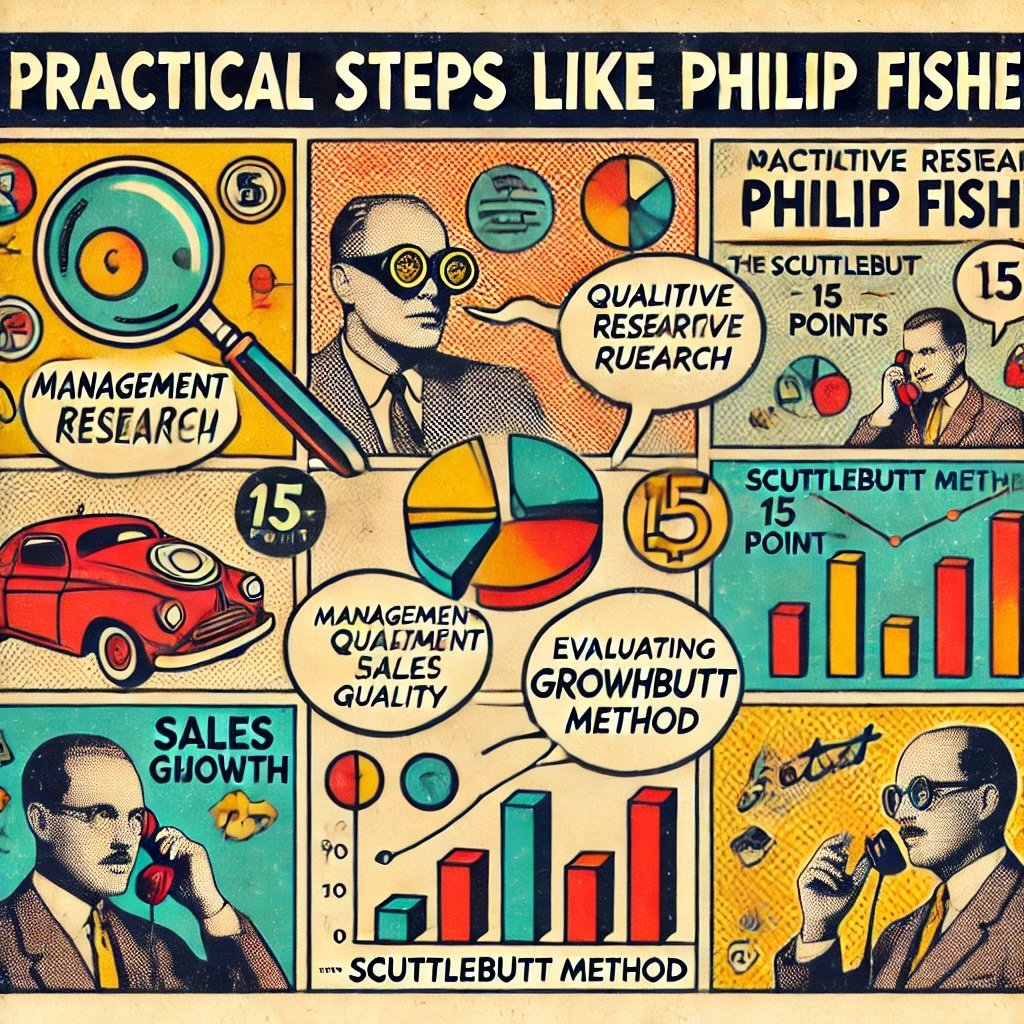Philip Fisher is widely regarded as one of the most influential figures in growth investing. His work, particularly his book Common Stocks and Uncommon Profits, has shaped the way investors approach stock selection and long-term wealth building. Fisher’s focus on qualitative analysis—understanding the people, processes, and culture behind a company—set him apart from his peers who largely relied on quantitative metrics alone. His philosophy has not only stood the test of time but also served as a foundation for future investing greats like Warren Buffett, who credited Fisher with broadening his investment horizon.
source: The Swedish Investor on YouTube
Fisher’s legacy is embedded in the practice of buying high-quality companies and holding them for the long term. He believed that the best investments come from businesses with solid growth potential, strong leadership, and the ability to innovate. This focus on growth through innovation and management quality transformed the investment landscape, influencing modern investors to look beyond balance sheets and earnings reports.
- Pioneering Growth Investor: Fisher’s methods shifted the focus toward understanding companies’ future potential, rather than just their present value.
- Influence on Modern Investors: His teachings continue to guide the strategies of renowned investors today.
- Qualitative Focus: Emphasized the importance of understanding the business behind the numbers.
Tip for Best Practices: Study the management and culture of companies in which you plan to invest. These intangible qualities often reveal the company’s long-term potential better than financial metrics alone.

Overview of Philip Fisher
This article aims to explain Philip Fisher’s investment philosophy as laid out in Common Stocks and Uncommon Profits and to show how his ideas are still applicable in today’s investing landscape. Fisher’s approach is not about quick gains or speculative trades. Instead, it’s about finding exceptional companies with the potential for sustained growth and holding them long enough to see that growth materialize. We will break down his strategies, focusing on key concepts such as qualitative analysis, scuttlebutt research, and the 15 points Fisher used to evaluate stocks.
While financial metrics are important, Fisher’s focus was on long-term growth driven by strong management, innovation, and company culture. This article will provide practical steps on how to implement Fisher’s philosophy in your own investing journey, whether you’re a beginner or an experienced investor.
- Explaining Fisher’s Philosophy: Learn the key principles of growth investing through Fisher’s eyes.
- Long-Term Focus: Understand how patience and qualitative research are essential to identifying winning investments.
- Practical Application: Apply Fisher’s techniques to build a portfolio of growth-focused investments.
Tip for Best Practices: Focus on the long-term potential of your investments. Short-term market movements are often noise; true value is revealed over time through careful analysis and patience.

Introduction to Fisher’s Focus
At the core of Fisher’s philosophy is the idea that investing is about more than just numbers. While financials are essential, they only tell part of the story. Fisher believed that truly successful investing involves understanding the business behind the stock—its leadership, its capacity for innovation, and its ability to sustain growth over time. His “scuttlebutt” method, which involved gathering information from various sources such as employees, customers, and suppliers, was central to his research process. This approach allows investors to gain insights that aren’t immediately obvious from financial statements alone.
In Fisher’s view, investing should focus on companies that have room to grow and leaders who are committed to making that growth happen. He also emphasized the importance of innovation and research and development (R&D), noting that companies that consistently innovate are better positioned to stay ahead of their competition. His 15-point checklist for evaluating stocks is a reflection of this focus on both qualitative and quantitative factors, balancing the importance of hard numbers with a deep understanding of the business itself.
- Beyond Financials: Fisher emphasized understanding the company’s culture, leadership, and long-term growth potential.
- Innovation and R&D: Companies that innovate are more likely to sustain growth over the long term.
- Long-Term Focus: Successful investing requires patience, discipline, and a deep understanding of the business.
Tip for Best Practices: When evaluating potential investments, consider both the company’s financial performance and its ability to innovate and lead its industry. Strong leadership and a focus on R&D are often indicators of future success.

The “Scuttlebutt” Approach
What is the Scuttlebutt Method?
One of Philip Fisher’s most well-known contributions to the world of investing is his “scuttlebutt” method. This technique is all about gathering information from on-the-ground sources—employees, customers, suppliers, and even competitors—to gain a deeper understanding of a company’s inner workings. Fisher believed that by talking to people who interact with the company regularly, an investor could uncover valuable insights that wouldn’t be found in financial reports alone.
For Fisher, the goal was to understand how a company operates day-to-day, how it treats its customers, and how it stands against its competitors. Is the company fostering a positive culture? Is it innovative? Is management competent and transparent? These are the kinds of qualitative details the scuttlebutt method seeks to uncover. Fisher viewed this research as a way to look behind the scenes of a company and identify opportunities or risks that may not be immediately apparent from surface-level analysis.
- Scuttlebutt Defined: A research method involving informal conversations with various stakeholders of a company.
- Qualitative Insights: Focuses on gathering qualitative data from people who directly interact with the company.
- Behind the Scenes: Helps investors understand how a company truly operates beyond just the financial metrics.
Tip for Best Practices: When researching a company, think outside the box. Talk to people who interact with the business regularly—whether it’s suppliers, employees, or customers—to get a fuller picture.

How to Conduct Scuttlebutt Research
Conducting scuttlebutt research doesn’t require formal training, but it does require curiosity and persistence. The process begins by identifying key people who have direct knowledge of the company’s operations. This could be employees at various levels, customers who use the product or service, or even competitors who have insights into the company’s market position.
Once you’ve identified these sources, the next step is to have open conversations. Ask about the company’s strengths and weaknesses, the quality of its management, and whether it’s seen as an innovator in the field. Don’t be afraid to ask tough questions—sometimes the most valuable insights come from learning about a company’s flaws, not just its strengths.
Here are some practical tips for conducting scuttlebutt research:
- Talk to Employees: Employees can provide valuable insights into the company culture, management effectiveness, and operational challenges.
- Engage with Customers: Customers can tell you whether the company delivers on its promises and whether its products or services offer value.
- Connect with Suppliers: Suppliers often know how a company manages its relationships and how efficiently it operates.
- Reach Out to Competitors: Competitors can offer an external perspective on how the company stacks up in terms of innovation, pricing, and market positioning.
Tip for Best Practices: When talking to stakeholders, ask open-ended questions that encourage detailed responses. Focus on both the positives and negatives to get a well-rounded view of the company.

Example: Scuttlebutt Success Stories
Fisher’s scuttlebutt method has proven successful in several of his most iconic investments. One of the most notable examples is his investment in Texas Instruments (TI) in the 1950s. At the time, TI was a relatively unknown player in the burgeoning semiconductor industry. Through his scuttlebutt research, Fisher spoke with engineers, competitors, and suppliers who were familiar with TI’s operations. He discovered that the company was far ahead of its peers in research and development, particularly in silicon transistors—an innovation that would later revolutionize the electronics industry.
Fisher’s scuttlebutt work revealed that while TI’s financials weren’t yet impressive, its commitment to innovation and its skilled management team made it a solid long-term investment. As a result, Fisher bought shares of TI and held them as the company grew into a leader in the semiconductor market, delivering significant returns to his portfolio.
Another example is Fisher’s investment in Motorola. Fisher used the scuttlebutt method to gather information about Motorola’s dedication to research and development. By speaking with competitors and industry insiders, he learned that Motorola was making significant strides in mobile communication technology. While the market hadn’t fully recognized Motorola’s potential at the time, Fisher’s in-depth scuttlebutt research gave him the conviction to invest early, which later paid off handsomely as the company became a major player in the telecommunications industry.
- Texas Instruments: Fisher’s conversations with engineers and suppliers highlighted the company’s innovation in semiconductors, leading to a successful long-term investment.
- Motorola: By gathering information on the company’s research efforts, Fisher saw the future potential in mobile communications, well before the market did.
- Key Insight: The scuttlebutt method allowed Fisher to identify these companies’ potential before they became industry leaders, demonstrating the power of qualitative research.
Tip for Best Practices: Follow up with multiple sources to validate the information you receive. The more data points you have, the clearer the picture of the company becomes.

Fisher’s 15 Points to Look for in a Stock
Overview of the 15 Points
Philip Fisher is perhaps best known for his 15 points—a set of criteria he developed to evaluate the long-term potential of a company. These points focus on qualitative and quantitative factors, from financial performance to management quality and innovation. Fisher believed that by thoroughly analyzing these aspects, investors could identify companies that would deliver sustained growth and strong returns over time.
Some of the most important points Fisher looked for included:
- Sales Growth: Fisher emphasized the importance of consistent sales growth, as it reflects a company’s ability to expand its market share and stay competitive.
- Profit Margins: Companies with strong and improving profit margins are usually better positioned to weather economic downturns and reinvest in their own growth.
- R&D and Innovation: Fisher was particularly focused on a company’s research capabilities, especially in industries where technological advancements could be a key differentiator.
- Management Quality: A capable and trustworthy management team is critical for long-term success. Fisher looked for managers who prioritized the company’s growth and innovation over short-term profits.
- Customer Relations: Fisher believed that a company’s relationship with its customers was a direct indicator of future success. Strong customer loyalty often leads to steady sales and repeat business.
These 15 points, while comprehensive, weren’t rigid rules. Fisher treated them as guidelines to ensure that he was investing in companies with strong potential for future growth, even if they weren’t perfect in every area.
Key Points of Focus:
- Sales Growth: Consistency in revenue expansion.
- Profit Margins: Improving and stable profit margins.
- Innovation and R&D: Strong commitment to research and innovation.
- Management Quality: Leadership with integrity and long-term vision.
Tip for Best Practices: Don’t rely on just one or two factors when analyzing a stock. A holistic view, covering both financials and qualitative aspects, will lead to better long-term investments.

Applying the 15 Points
Applying Fisher’s 15 points to your own investment analysis requires looking beyond the numbers. While financials are a key component, the real value comes from understanding the company’s ability to grow sustainably over the long term. Here’s how you can start applying these points:
- Examine Sales Growth: Begin by reviewing the company’s revenue trends over several years. Are they consistently growing? If not, does the company have a plan to reverse any downturns?
- Check Profit Margins: Look at both gross profit and net profit margins. Are these margins expanding over time? Companies with widening profit margins tend to be better equipped to manage operational costs and invest in future growth.
- Assess Research Capabilities: Investigate the company’s investment in R&D. Does it have a strong innovation pipeline? In industries like tech or healthcare, innovation can be the key to staying ahead of competitors.
- Evaluate Management: Research the leadership team. What is their track record? Do they prioritize long-term growth over short-term shareholder gains? You can also use the scuttlebutt method to gather insights about management from industry insiders.
- Analyze Customer Relationships: Are customers loyal to the company’s products or services? Look for reviews, customer retention rates, and any available feedback that indicates whether customers are satisfied and likely to return.
By applying these points, investors can gain a more complete picture of a company’s strengths and weaknesses. Fisher believed that if a company met a majority of these criteria, it was worth considering for a long-term investment.
- Start with Sales Growth: Look at revenue trends over a multi-year period.
- Check Profit Margins: Focus on whether they are expanding and stable.
- Investigate R&D: See how much the company is investing in future innovation.
Tip for Best Practices: Always consider the long-term outlook of the company. Short-term fluctuations may cloud judgment, but if a company meets most of Fisher’s criteria, it’s likely a strong candidate for long-term growth.

Focus on Long-Term Growth
Buy and Hold Strategy
Philip Fisher was a firm believer in the buy and hold strategy. His approach to investing was centered around finding high-quality companies with significant long-term growth potential, and then holding onto them for extended periods—sometimes even decades. For Fisher, the key was not just to invest in a company but to become a partner in its growth journey. He was convinced that the best returns come from identifying businesses that are poised for sustained growth, and then giving them the time needed to mature and fully realize their potential. This long-term focus is a stark contrast to the more speculative, short-term strategies that many investors pursue today.
Rather than timing the market or trading based on short-term price fluctuations, Fisher emphasized the importance of understanding a company’s fundamentals and sticking with it through thick and thin. He would often advise investors to look beyond the noise and remain focused on the long-term value that a well-managed company could create.
- Long-Term Vision: Fisher believed in buying companies that could grow consistently over time, rather than seeking quick gains.
- Partnership Mindset: He viewed investing as partnering with companies for the long haul, allowing them to compound growth.
- Focus on Fundamentals: Fisher’s investments were based on solid company fundamentals rather than market trends or price movements.
Tip for Best Practices: When you find a company with strong fundamentals, think of yourself as a long-term partner, not just a shareholder. Let the company’s growth unfold naturally over time.
Patience and Conviction
In addition to his long-term strategy, Fisher stressed the importance of patience and conviction. He believed that holding onto high-quality stocks during market fluctuations was crucial for maximizing returns. While many investors panic during market corrections or downturns, Fisher understood that market volatility was inevitable, and that it often presented opportunities for investors who were patient enough to stay the course.
He maintained that if a company’s fundamentals remained intact, there was no reason to sell just because of temporary setbacks or broader market downturns. Fisher’s conviction in the companies he invested in allowed him to weather these storms, often coming out with even greater returns as the market corrected itself over time.
This approach required a high level of confidence in the investment thesis and a willingness to ignore short-term market noise. Fisher’s patience with his investments wasn’t just about holding on—it was about having the foresight and discipline to wait for the company to grow into its full potential.
- Stay the Course: Fisher believed in holding high-quality stocks even through periods of market volatility.
- Confidence in Fundamentals: If a company’s core business is strong, market fluctuations shouldn’t trigger a sell.
- Ignore the Noise: Fisher’s strategy involved ignoring short-term price movements in favor of long-term growth potential.
Tip for Best Practices: Patience is key when investing for the long term. Don’t let short-term market fluctuations shake your confidence in a well-researched investment.

Avoiding the Common Pitfalls
Avoiding Hype Stocks
Philip Fisher was a strong advocate of steering clear of hype stocks—those that are popular and have inflated valuations but lack solid fundamentals. Fisher believed that while these stocks might be the talk of the market for a time, they often lack the underlying business strength to support their high valuations. The result? A lot of volatility and potential losses for investors who chase after the latest “hot” stock.
Instead, Fisher advised focusing on companies with strong fundamentals: consistent sales growth, strong management, a solid competitive position, and the ability to innovate. These qualities, he believed, would lead to sustainable long-term growth, whereas hype stocks could quickly crash as soon as the market’s excitement faded. The excitement around trendy stocks can be tempting, but Fisher stressed the importance of discipline—sticking to companies that make sense on paper, not just in market sentiment.
- Steer Clear of Trends: Don’t get sucked into the latest market fads. Stay grounded in fundamentals.
- Focus on Substance, Not Popularity: The best investments are in companies with long-term value, not those riding a wave of hype.
- Avoid Market Bubbles: Stocks with inflated valuations are often at risk of sharp declines when the bubble bursts.
Tip for Best Practices: Before investing in a popular stock, take a step back. Are the fundamentals strong, or is it just the market riding a wave of excitement? Make decisions based on real value, not hype.
Don’t Overdiversify
Another pitfall Fisher cautioned against is overdiversification. While diversification can help manage risk, spreading investments too thinly across too many companies can dilute your returns. Fisher believed that it was better to concentrate on a smaller number of high-conviction investments where you have deep confidence in the company’s potential. The more stocks you add to your portfolio, the harder it becomes to keep track of each one’s performance and fundamentals, which can lead to subpar decision-making.
By focusing on fewer, higher-quality investments, Fisher argued that investors could achieve better overall returns. A concentrated portfolio allows you to stay more engaged with each company, understanding its inner workings and following its growth more closely. This doesn’t mean putting all your eggs in one basket, but rather focusing on a select few high-potential companies that align with your investment strategy.
- Too Many Stocks Dilute Returns: Spreading your investments across too many companies can weaken your overall portfolio performance.
- Focus on High-Conviction Investments: Choose fewer stocks where you have confidence in their long-term potential.
- Stay Engaged: With a concentrated portfolio, it’s easier to stay on top of developments and make informed decisions.
Tip for Best Practices: Limit the number of stocks in your portfolio to those you have high confidence in. More isn’t always better—depth of understanding can lead to better investment decisions.
Staying Focused
Staying focused on high-conviction investments is a hallmark of Fisher’s strategy. He believed in thoroughly researching a company and, once convinced of its potential, sticking with it despite market noise or trends. Fisher’s confidence in his analysis allowed him to ignore short-term distractions and the constant flow of information that could cause many investors to panic. He knew that the key to long-term success was staying focused on a company’s fundamentals and long-term growth, rather than reacting impulsively to short-term price movements.
The modern market is noisy, with endless information and opinions bombarding investors daily. It’s easy to get distracted by the latest headlines, analysts’ predictions, or momentary market swings. Fisher’s strategy serves as a reminder to stay disciplined and focus on your investment thesis. If you’ve done your research and believe in the long-term potential of a company, stick with it. Don’t be swayed by temporary market trends.
- Stick to Your Research: Once you’ve found a high-quality investment, stay focused on the long-term thesis.
- Ignore Market Noise: Don’t let daily fluctuations or media hype distract you from your investment strategy.
- Confidence in Conviction: Trust your research and be willing to ride out market turbulence if the fundamentals are still strong.
Tip for Best Practices: Once you’ve made a high-conviction investment, revisit your research periodically to ensure the company is still on track, but avoid making knee-jerk reactions to short-term market movements.

Practical Steps to Invest Like Philip Fisher
Start with Qualitative Research
To invest like Philip Fisher, your first step should be focusing on qualitative research. While numbers and financial ratios are important, Fisher emphasized the need to understand the business behind the stock. Start by digging into the company’s fundamentals. Look at its management team, the company culture, and the industry dynamics. You want to understand not just what the company does, but how it operates and whether it has the potential to grow sustainably over time.
Key areas to focus on include:
- Management Quality: Does the leadership have a solid track record? Are they long-term thinkers who focus on growth rather than short-term profits?
- Company Culture: A company’s culture often determines its long-term success. Is it fostering innovation? Are employees engaged and motivated?
- Industry Dynamics: Is the company positioned well within its industry? Does it have a competitive edge?
Fisher believed that a good understanding of these qualitative factors is critical for identifying companies with strong long-term potential.
- Study Management: Research the leaders running the company. Are they transparent, competent, and long-term focused?
- Understand the Culture: Learn about the company’s internal culture. A strong, innovative culture often drives long-term success.
- Examine Industry Trends: Analyze the company’s competitive position within its industry. Is it positioned for sustainable growth?
Tip for Best Practices: Don’t rush the research process. Take time to gather insights and build a deep understanding of the company’s operations and its ability to succeed over the long term.
Using the Scuttlebutt Method
Fisher’s scuttlebutt method is an excellent way to gain valuable, on-the-ground insights into a company. This approach involves gathering information from people who interact with the company—its employees, customers, suppliers, and even competitors. By speaking to these individuals, you can learn about the company’s strengths, weaknesses, and reputation from multiple perspectives.
To apply the scuttlebutt method, start by identifying the key stakeholders who can provide insights into the company. This could involve reading reviews from employees on sites like Glassdoor, talking to customers, or even reaching out to suppliers. If you’re invested in a product-based company, using the product yourself and reading customer reviews can give you a first-hand understanding of how well the company delivers on its promises.
- Talk to Employees: Employees often have the best insights into company culture, management quality, and operational challenges.
- Engage with Customers: Customer satisfaction is a good indicator of whether the company is delivering value and building brand loyalty.
- Speak to Suppliers: Suppliers can give you insights into how well the company manages its relationships and whether it operates efficiently.
Tip for Best Practices: Be thorough in your research. The more people you talk to, the better you can understand the company’s inner workings and long-term prospects.
Evaluating Growth Potential Using Fisher’s 15 Points
Once you’ve gathered qualitative insights, it’s time to evaluate a company’s growth potential using Fisher’s 15 points. These points cover a range of factors, from financial health to innovation and management quality. Fisher’s checklist helps ensure that the company not only has the potential for growth but also the internal resources to sustain that growth over the long term.
Here’s how you can apply some of Fisher’s 15 points in your analysis:
- Sales Growth: Is the company growing its revenues consistently? Look at multi-year trends to assess its ability to expand its market share.
- Profit Margins: Are the company’s profit margins stable or improving? Consistent margins suggest operational efficiency and pricing power.
- Research and Development: Does the company invest in R&D? A company that prioritizes innovation is more likely to stay ahead of the competition.
- Management Quality: Do leaders prioritize long-term growth? Fisher always looked for leaders with vision, integrity, and the ability to adapt to changing market conditions.
Evaluating growth potential requires patience and a willingness to dig deep into these factors. Companies that meet most of Fisher’s criteria are typically worth considering for long-term investments.
- Look at Sales Growth: Examine multi-year trends to gauge the company’s ability to grow consistently.
- Check Profit Margins: Improving or stable margins indicate operational efficiency.
- Research and Innovation: Companies with a strong focus on R&D are often better positioned for long-term success.
Tip for Best Practices: Don’t expect a company to score perfectly on all 15 points. However, if it checks off most of Fisher’s key criteria, it’s likely a strong contender for your portfolio.
By following these practical steps, you can start investing like Philip Fisher. Focus on qualitative research, use the scuttlebutt method to gain unique insights, and apply Fisher’s 15 points to evaluate a company’s growth potential. Fisher’s approach emphasizes long-term value creation, allowing you to build a portfolio of high-quality stocks that can grow steadily over time.
How to Invest Like Philip Fisher: 12-Question FAQ
1) Who was Philip Fisher and why does he matter?
Philip A. Fisher (1907–2004) pioneered growth investing with a qualitative edge, popularized in Common Stocks and Uncommon Profits. He taught investors to study a company’s management, innovation engine, customers, and culture—not just its ratios. Warren Buffett has credited Fisher with broadening his thinking from pure value to great businesses at fair prices.
2) What is Fisher’s core philosophy in one sentence?
Buy a truly exceptional company with a long runway for growth, run by competent, candid management, and hold it for years while the business compounds—provided the original thesis remains intact.
3) What is Fisher’s “scuttlebutt” method?
It’s structured shoe-leather research: talk to customers, suppliers, competitors, ex-employees, distributors, trade associations, and domain experts to triangulate product quality, customer love, R&D vigor, talent density, salesforce effectiveness, and reputation—insights you won’t find in financials alone.
4) What are Fisher’s famous “15 Points”?
A qualitative checklist probing: (1) sizable market & sales growth runway, (2) strong R&D, (3) superior sales organization, (4) high profit margins, (5) margin resilience, (6) labor relations, (7) executive depth, (8) accounting integrity, (9) cost controls, (10) competitive moat, (11) industry leadership, (12) long-term plans, (13) adaptability, (14) capital allocation skill, (15) management candor. (Wording varies by edition; substance is consistent.)
5) Did Fisher care about valuation?
Yes—he preferred quality first, then reasonable price: look for temporary misunderstandings or under-appreciated growth rather than bargain-bin mediocrities. He emphasized future earnings power over static multiples.
6) How concentrated should a Fisher-style portfolio be?
Fisher argued against over-diversification. A focused set of well-researched, high-conviction positions (think dozens, not hundreds) lets you truly know what you own and capture outsized compounding from your best ideas.
7) What are Fisher-style “green flags” during research?
Customers evangelize the product (retention, NPS, switching costs).
R&D translates to shipping innovations, not just patents.
Sales culture is respected, not feared; incentive design is rational.
Talent attracts talent; low regrettable attrition.
Management is candid, detail-oriented, and plays the long game.
8) What are Fisher-style “red flags”?
Growth driven mainly by price hikes or M&A roll-ups (not true demand).
Opaque accounting or frequent “one-time” adjustments.
Showy announcements with little follow-through.
Customer gripes about quality/service that don’t resolve.
Churn in key leaders; defensive culture; R&D starved.
9) When would Fisher consider selling?
Three big reasons: (1) thesis impairment (competitive erosion, culture break, poor capital allocation), (2) better Fisher-worthy idea emerges for limited capital, (3) management breaches trust (candor, accounting, capital misuse). Market volatility alone is not a reason.
10) How do I apply Fisher’s method in today’s markets?
Pair scuttlebutt with modern signals: product telemetry (where public), developer adoption, community health, Glassdoor trendlines, customer review depth, open-source velocity, industry conference chatter, alternative data—but always validate with direct conversations.
11) What practical, repeatable process can I use?
Screen for growth + moat signals.
Scuttlebutt plan: list 10–20 stakeholder interviews.
Score the 15 Points (traffic-light ratings).
Model the unit economics and reinvestment loop.
Size the position based on conviction + downside.
Set review cadences (quarterly thesis check, annual deep dive).
12) What resources should I read to go deeper?
Common Stocks and Uncommon Profits (Fisher)
Paths to Wealth through Common Stocks (Fisher)
Berkshire letters (Buffett on “wonderful businesses”)
Industry trade journals / conference proceedings for your target sectors
Important Information
Comprehensive Investment Disclaimer:
All content provided on this website (including but not limited to portfolio ideas, fund analyses, investment strategies, commentary on market conditions, and discussions regarding leverage) is strictly for educational, informational, and illustrative purposes only. The information does not constitute financial, investment, tax, accounting, or legal advice. Opinions, strategies, and ideas presented herein represent personal perspectives, are based on independent research and publicly available information, and do not necessarily reflect the views or official positions of any third-party organizations, institutions, or affiliates.
Investing in financial markets inherently carries substantial risks, including but not limited to market volatility, economic uncertainties, geopolitical developments, and liquidity risks. You must be fully aware that there is always the potential for partial or total loss of your principal investment. Additionally, the use of leverage or leveraged financial products significantly increases risk exposure by amplifying both potential gains and potential losses, and thus is not appropriate or advisable for all investors. Using leverage may result in losing more than your initial invested capital, incurring margin calls, experiencing substantial interest costs, or suffering severe financial distress.
Past performance indicators, including historical data, backtesting results, and hypothetical scenarios, should never be viewed as guarantees or reliable predictions of future performance. Any examples provided are purely hypothetical and intended only for illustration purposes. Performance benchmarks, such as market indexes mentioned on this site, are theoretical and are not directly investable. While diligent efforts are made to provide accurate and current information, “Picture Perfect Portfolios” does not warrant, represent, or guarantee the accuracy, completeness, or timeliness of any information provided. Errors, inaccuracies, or outdated information may exist.
Users of this website are strongly encouraged to independently verify all information, conduct comprehensive research and due diligence, and engage with qualified financial, investment, tax, or legal professionals before making any investment or financial decisions. The responsibility for making informed investment decisions rests entirely with the individual. “Picture Perfect Portfolios” explicitly disclaims all liability for any direct, indirect, incidental, special, consequential, or other losses or damages incurred, financial or otherwise, arising out of reliance upon, or use of, any content or information presented on this website.
By accessing, reading, and utilizing the content on this website, you expressly acknowledge, understand, accept, and agree to abide by these terms and conditions. Please consult the full and detailed disclaimer available elsewhere on this website for further clarification and additional important disclosures. Read the complete disclaimer here.




